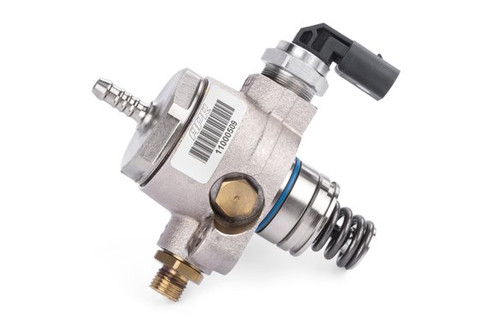Overview
The APR High Pressure Fuel Pump (HPFP) dramatically increases the maximum volume of fuel the HPFP can deliver. In doing so, the direct injection fueling system is capable of satisfying fueling requirements set forth by high horsepower setups. This is accomplished by increasing the displacement of the pump using high quality components to exacting tolerances. How the direct injection system works: A low pressure fuel pump (LPFP) in the fuel tank delivers fuel to the high pressure fuel pump (HPFP) at roughly 4 to 6 bar. Fuel pressure is then bumped up to a maximum of 200 bar, depending on factory parts, with the HPFP. Finally, high pressure fuel is delivered to the injectors, which spray directly into the cylinders. The problem: The volume of fuel the HPFP pump can displace is directly tied to the displacement of the pump (Internal bore size, and camshaft dictated stroke), and engine speed. The pump is driven off of a lobe on the camshaft. Larger turbocharger systems, and ethanol usage are capable of taxing this system, especially in the mid to lower RPM range where fuel volume is lower. The APR solution: We dramatically increase the volume of fuel the HPFP can displace at every RPM by increasing the displacement of the HPFP. This is accomplished by increasing the bore diameter of the pump's internal pressurizing cylinder. It's important to understand, despite the name, a HPFP upgrade is not necessary designed to increase the engine's fuel rail pressure. The primary goal is to increase the volume of fuel available, which will keep fuel pressure steady even in the most demanding of situations! High quality components and extreme tolerances: The HPFP internals must be machined to extreme tolerances and installed in a clean environment or the pump can easily fail. Dimensional tolerances on the APR HPFP are as tight as .00004" and geometric tolerances are as tight as .00005". The plunger and barrel are created from certified and heat-treated bearing-grade stainless steel and the plunger undergoes a special diamond like coating process for exceptional surfaces hardness and ultra-reliable operation. To prevent float associated with altering the plunger's mass, APR supplies each unit with a properly specified spring. All necessary internal seals are replaced. Internal testing: All APR HPFPs are assembled in house under strict assembly guidelines. Each pump is then tested on our test rig to ensure the pumps operate as designed. This step is important for several reasons. It's critical in determining if a pump has a failure from incorrect install, a leaking seal, or a bad solenoid. Secondly, a seized pump on the vehicle at startup can cause damage to the engine's camshaft. By testing each pump, we all but eliminate these possibility. Proven track record: APR pioneered HPFP upgrades in the early days of VAG direct injection engines. Soon after, APR became an OEM supplier of HPFP and GDI components to VAG for use in various race cars, racing series, project cars, and concept vehicles. The APR HPFP has been at the center of countless motorsport victories across the globe and has operated with a nearly perfect tract record since the program's motorsport backed inception in 2006. With tens of thousands of pumps sold, APR has a wealth of knowledge, and manufacturing expertise necessary to deliver a product that will and has stood the test of time. This kit includes a new rebuilt pump.
Features:
- Dramatically increases the volume of fuel displaced by the HPFP
- Maintains higher pressures under demanding situations
- Fully rebuilt in house
- Fully machine tested and broken in before shipping
- Includes a new OEM pump
- Upgraded and weight matched spring
- DLC coated piston
- Heat-treated bearing-grade stainless steel material
- Over 5,500 CC/MIN at 7,500 RPM
- .00004" dimensional tolerances
- .00005" geometrical tolerances



















